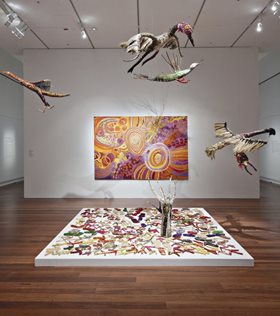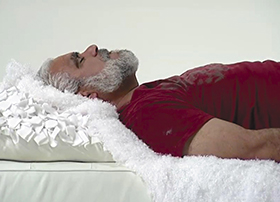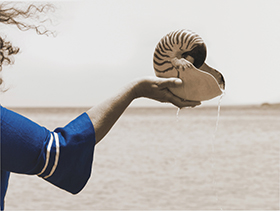 A Difficult Remit
A Difficult Remit
Words by Anna Waldmann
April 2014
The public funding of art in Australia has a long history, from Governor Macquarie’s support for artist John Lewin, to the weird and wonderful transition time from the Commonwealth Arts Advisory Board to the Australia Council’s Visual Arts Board in 1972-73 which saw the funding of Bonnard’s Self Portrait for the Art Gallery of New South Wales and Turner’s Val d’Aosta for the National Gallery of Victoria collections.
Since then, the visual arts have become a complex territory: contemporary art spaces, touring agencies, regional galleries, artist run initiatives, university galleries, state and national art museums, art magazines, commercial galleries, artfairs, auction houses, prizes, biennales and private museums.
The most complex of the publicly funded organisations are public art galleries. People hold strong opinions about art museums. Some assert that their function should be scholarship; others insist that it’s more important to communicate with a wide audience. Many believe their focus is exploring art objects, others that it’s investigating their contexts; looking at things as opposed to telling stories; special places for contemplation, or part of democratising our access to art; state, national or international issues.
The pressure to represent the local arts community by collecting and exhibiting its artists is increasing, but it has to be balanced against the demand for blockbusters and acquisitions for historical collections, and negotiated alongside the activities of contemporary art spaces and regional as well as commercial galleries.
Here is a brief overview of how some of Australia’s major public art museums consider their contemporary art obligations, sourced from publicly available annual reports, policy statements, strategic documents and press releases.
The Art Gallery of New South Wales has little funds to buy or exhibit art. According to its 2012 annual report, from $67m in revenue, only $27m came from the NSW Government. Its Art Acquisitions Policy states, ‘’The Gallery’s commitment to contemporary culture is demonstrated by the depth and breadth of our contemporary Australian art collection. The Gallery represents key art movements, thematic concerns and the work of individual artists through the acquisition of significant representative artworks. Contemporary art is the fastest growing area of the Australian collection, reflecting the energy and quality of contemporary art practice. Demonstrable support of living culture through collecting is essential to the Gallery’s role as a leading art museum.’’
The gallery has managed, with corporate sponsorship and private philanthropy to acquire and show a range of Australian contemporary art. In 2012-13 its various projects showed the work of Jacky Redgate, Eugenia Raskopoulos, Kathy Temin, collaborative duo Ms&Mr, Simone Mangos, Bill Henson, Cate Consandine, Shaun Gladwell, Tony Albert, the biennial Anne Landa Award for Video and New Media Arts, and the Balnaves Contemporary. In 2013 some 584 artworks entered the collection, including Mike Parr, Ken Unsworth, Tim Silver, Jenny Watson, John Beard, Peter Atkins, Imants Tillers, Peter Tyndall, Michael Zavros, Debra Phillips, Jon Cattapan, Sangeeta Sandrasegar, Ben Quilty and Angelica Mesiti.
 The National Gallery of Victoria has been benefitting for more than a decade from the Victorian Foundation for Living Australian Artists established with a grant of $5m from the Victorian Government, matched by an equal contribution from the Council of Trustees, to increase support for living Australian artists by purchasing and exhibiting Australian art. It showed the result of this considerable investment in the exhibition Negotiating this World: Contemporary Australian Art. It also exhibited Mix Tape 1980s: Appropriation, Subculture, Critical Style; Brent Harris; The Art and Design of Contemporary Jewellery; Confounding: Contemporary Photography and the exuberant Melbourne Now, showing more than 175 individual and group presentations by Victorian artists, designers and architects.
The National Gallery of Victoria has been benefitting for more than a decade from the Victorian Foundation for Living Australian Artists established with a grant of $5m from the Victorian Government, matched by an equal contribution from the Council of Trustees, to increase support for living Australian artists by purchasing and exhibiting Australian art. It showed the result of this considerable investment in the exhibition Negotiating this World: Contemporary Australian Art. It also exhibited Mix Tape 1980s: Appropriation, Subculture, Critical Style; Brent Harris; The Art and Design of Contemporary Jewellery; Confounding: Contemporary Photography and the exuberant Melbourne Now, showing more than 175 individual and group presentations by Victorian artists, designers and architects.
The NGV’s 2013 annual report acknowledges a good budget of $43m from Victorian Government grants, $23m from trade revenue and over $11m from numerous gifts and bequests. Last year it purchased and accepted over 800 works (including design and decorative arts) from artists such as Eugene Carchesio, Shaun Gladwell, Ash Keating, Tracey Moffatt, Laith McGregor, Lindy Lee, Dick Watkins, Robert Rooney, Dale Frank, Polixeni Papapetrou, Andrew McQualter, Texta Queen, Ricky Swallow, Callum Morton, and Michelle Ussher. The NGV Collection Strategy is clear on its obligation toward contemporary art, “The Department of Contemporary Art encompasses Australian and International art and is responsible for painting, sculpture, installation, video and (Australian) decorative arts and design from 1980 to the present day...The Department will continue to actively build the collection of contemporary Australian art encompassing emerging, mid-career and senior artists, while orienting additional focus and support toward new and ambitious established and emerging practices.”
Since it opened in 1991, the Museum of Contemporary Art Australia has claimed its national and international responsibilities. “Collecting is a vital part of the MCA’s support for Australian artists: collecting as well as exhibiting is crucial in terms of endorsing the importance of preserving Australian art for future generations. …Since 2003 the MCA has focused on building its collection with the acquisition of major works by Australian artists from the past ten years; work by Aboriginal and Torres Strait Islander artists; work by young Australian artists who have exhibited in the MCA’s annual Primavera exhibition and work for the MCA’s Contemporary Art Archive.”
Last year the MCA showed a mix of international blockbusters such as Anish Kapoor, Yoko Ono and Jeff Wall as well as Australian exhibitions including string theory: Focus on contemporary Australian art, Primavera, Craig Walsh, New Acquisitions in Context and South of no North: Laurence Aberhart, William Eggleston, Noel McKenna.
The Art Gallery of South Australia receives a South Australian Government grant of only $12m, but managed to raise a combined value of gifts of cash to fund purchases and donations of works of art of $5.8m in 2012-13. Of $2.2m cash donated to the Foundation, $307,644 was donated to Contemporary Collectors. Last year 513 works of art were acquired across all areas of the collection, including Peter Booth, Dale Frank, Paul Boston, David Noonan, Janet Laurence, Sam Leach, Aida Tomescu, Fiona Hall, Alexander Seton, Ricky Swallow, Ian North, and Tracey Moffatt. There were many exhibitions, important amongst them Anna Platten, HEARTLAND: Contemporary Art from South Australia and of course the significant Adelaide Biennial. Its Acquisitions Policy is clear about its obligations, “To collect Australian contemporary art (including Aboriginal and Torres Strait Islander art) as a special-emphasis program, in order to enable these works to take their place in the collection displays... To collect South Australian especially comprehensively, not only as suitable for display, but also as an art-history and social-history research resource. To collect works of art significantly representative of the full range of production by South Australian artists, of all periods, working in all visual-arts media and in all categories and classes of visual art.”
Queensland Art Gallery/Gallery of Modern Art received a Queensland Government annual grant of $31.3m contributing to a total annual income of $51m in 2012-13. In its annual report QAG|GOMA talks about its contemporary collections, “The Gallery has built its contemporary Australian art collection through the acquisition of exceptional works by key artists and by expanding on existing Collection strengths. In 2012–13, ‘Contemporary Australia: Women’ and APT7 provided the opportunity to make major acquisitions and to work with artists on significant commissions.” Out of 409 works accessioned through gifts, bequests and purchases, 117 works were for the contemporary Australian art collection including by artists Vernon Ah Kee, Ah Xian, Gordon Bennett, Vivienne Binns, Adrienne Doig, Juan Davila, Simryn Gill, Brent Harris, Claire Healy and Sean Cordeiro, Tim Johnson, Deborah Kelly, Scott Redford, William Robinson, Gosia Wlodarczak and Michael Zavros.
 The gallery is unambiguous on the role it plays: “[A]s Queensland’s state gallery, the Gallery’s Collection includes extensive holdings of work by Queensland artists, many of whom are nationally or internationally significant. Queensland artists whose work is held in depth by the Gallery include Gordon Bennett, Eugene Carchesio, Robert MacPherson, Tracey Moffatt, Scott Redford, William Robinson and Judith Wright.”
The gallery is unambiguous on the role it plays: “[A]s Queensland’s state gallery, the Gallery’s Collection includes extensive holdings of work by Queensland artists, many of whom are nationally or internationally significant. Queensland artists whose work is held in depth by the Gallery include Gordon Bennett, Eugene Carchesio, Robert MacPherson, Tracey Moffatt, Scott Redford, William Robinson and Judith Wright.”
The new director plans major solo exhibitions of leading Queensland-born artists and will lead a team of gallery and external curators to develop an exhibition of contemporary Queensland art over the next few years.
Last year the Art Gallery of Western Australia received just $11.2m from the WA Government, half of which was a service appropriation to cover staff costs, specific equipment, repairs and maintenance. AGWA generated revenue of $8m and received sponsorship in cash and in kind of $1.3m. During the year 95 works of art were collected, of which 90% were by Australian artists including 15 WA artists. It acquired around 80% of its purchases through its Foundation including the TomorrowFund which bought works by Daniel Crooks, Angelica Mesiti, Gabriella and Silvana Mangano, Ms&Mr and Anne Zahalka. The gallery’s Acquisition Policy identifies that it, “…aspires to develop the finest public art collection of Western Australian art in the State. The priority is to develop a comprehensive collection of Western Australian art and design; develop representative collections of nationally significant Australian art and design, and acquire a highly selective representation of international art and design. International works will add breadth and develop key strengths in the Collection and/or contextualise the achievements in Western Australian and Australian art and design. The Gallery places a high priority on the purchase of the art of today to create a legacy for future generations.”
The only major collecting institution that publicly acknowledges its limitations and context is the National Gallery of Australia, through its Vision (2005) and Acquisitions Policy (2006) documents: “The National Gallery of Australia’s collections were formed largely in the last quarter of the twentieth century... Its collections rightly reflect recent Australian history and, situated in the national political capital, should also be highly relevant to Australia’s contemporary strategic engagement. A great many publicly-funded exhibition spaces for contemporary art are to be found throughout the nation and also in Canberra. Even so the National Gallery should include contemporary projects in its program. But this should never be a main thrust of the program; the National Gallery should not compete with or threaten the role of Australia’s contemporary art spaces and museums of contemporary art.”
Some of the art museums discussed here are in transition, with recently appointed directors or new boards, ambitious visions and new aspirations.
To be relevant and avoid the potential crisis of cultural authority, art museums juggle many activities, most importantly, what they collect and what they exhibit.
Most institutions have encyclopaedic collections because that is how they started and how they were shaped by decades of gifts, bequests and acquisitions. That makes their obligations regarding contemporary art and local artists a difficult task to balance against their historical aspects and to some degree an unrealistic expectation. But one of the responsibilities that will not go away is responding to current ideas as well as material developments and providing opportunities for artists to create.
Anna Waldmann is an art consultant; visiting fellow at the College of Fine Arts, University of New South Wales; a board member of the Power Institute Foundation; on the editorial advisory board of Art and Australia; a former Art Gallery of NSW curator and former director of visual arts at the Australia Council.
This article featured in the Artsource Newsletter, Autumn 2014.